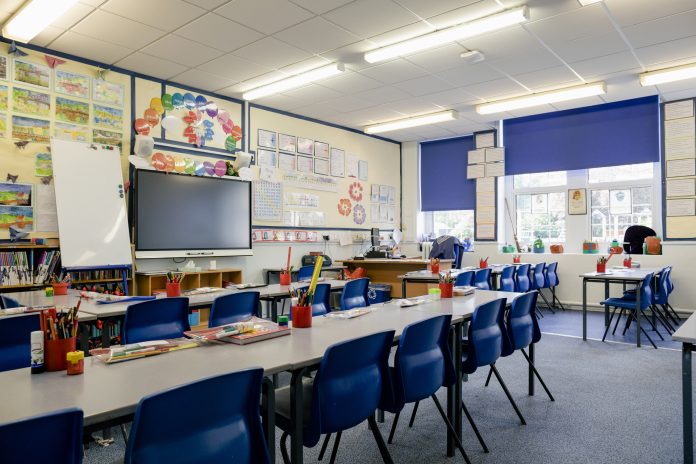Increasingly airtight buildings can lead to a build-up of carbon dioxide in educational facilities, which can affect the concentration of occupants and, therefore, their learning ability. Ventilation and air conditioning systems can, however, be designed to provide the best indoor air quality to maintain students’ alertness. Roberto Mallozi from Klima Therm explains
The carbon dioxide (CO2) level in a room is recognised as a key indicator of a building’s general indoor air quality. For medium-quality indoor air, a CO2 concentration of less than 1,000 ppm (parts per million) in occupied spaces is recommended, particularly to control odours and maintain comfort.
For comparison, outdoor air typically contains 350 to 400 ppm CO2. However, CO2 levels in a number of UK school and college classrooms have been found to be above 4,000 ppm. This is important because higher levels of CO2 reduce students’ attention spans, so they are more likely to lose their concentration, which may affect their ability to learn.
The problem has been exacerbated as building air-tightness standards have improved and infiltration ventilation rates in both new and refurbished educational buildings have reduced.
In many ways, of course, this is a good thing – after all, reducing energy consumption is a major part of sustainable building design. However, it has also led to a rise in CO2 levels in occupied areas such as classrooms.
This, in turn, has increased the need for effective ventilation and, in some cases, air conditioning in educational establishments, from nurseries to secondary schools, colleges, and universities.
A key reference document related to this area is ‘Building Bulletin BB101 – Ventilation, thermal comfort and indoor air quality’, which supports Building Regulations Part F in laying out the requirements for thermal comfort and indoor air quality in school buildings. Originally introduced in 2006, this landmark document was revised in 2018 and is primarily designed to:
• Describe the considerations for designing the indoor environment of schools.
• Establish the regulatory framework and recommended performance standards for schools.
• Provide a detailed guide to achieving the required levels of ventilation, indoor air quality, and thermal comfort.
BB101 recommends that ventilation should be provided to limit the concentration of CO2 in teaching and learning spaces so that, when measured at seated head height during the continuous period between the start and finish of teaching, the average concentration of CO2 does not exceed 1,500 ppm on any given day.
This demands that at any occupied time (including when teaching), the occupants should be able to lower the CO2 concentration to 1,000 ppm with extra ventilation. CIBSE TM40 (Technical Memorandum 40 from the Chartered Institution of Building Services Engineers) also recommends a limiting value of around 1,000 ppm.
Ventilation is the principal means of ensuring the occupied space contains fresh air to help create a stimulating learning environment. It can be natural, mechanical, or mixed mode.
Naturally ventilated schools (which basically involves opening windows) are common in the UK, but pressures on space and location now frequently dictate some form of mechanical ventilation.
Mechanical ventilation operates by employing fans to drive the flow of air into a building, by pressurising the building positively (supply ventilation system) or negatively (exhaust ventilation systems).
Mixed mode or hybrid systems, meanwhile, are often used to minimise the operational costs of mechanical ventilation systems. Mixed-mode ventilation uses natural airflow through the building whenever possible, but mechanical systems can be installed in spaces that require them to increase the ventilation rate.
However, there is an alternative to ventilation in educational premises. Air conditioning is gradually gaining a foothold in the sector as education authorities start to realise the benefits (see the box).
Not only can a comfortable environment help students study, but air conditioning can also be very cost-effective because some air conditioning units can produce both cool air and hot air.
Air conditioning can be particularly beneficial in schools and colleges that are full to capacity with big classes. After all, having many students in a restricted space can make it feel hot and stuffy.
Indeed, temperature is an important element of indoor air quality. The UK’s climate has changed over the years, with extreme temperatures becoming more ever frequent as a result of global warming. Heatwaves means that having a way to regulate the temperature in the classroom has never been more important since heat leads to a loss of concentration and increased tiredness.
A recent study – ‘Quantifying overheating risk in English schools: A spatially coherent climate risk assessment’ – confirms the problem. It found that English schools could exceed an ‘overheating threshold’ of 26°C for one-third of the academic year if global warming reaches 2°C above pre-industrial temperatures.
Contact Klima-Therm on 020 8971 4195 or email sales@klima-therm.co.uk for further details. www.klima-therm.co.uk

This work is licensed under Creative Commons Attribution-NonCommercial-NoDerivatives 4.0 International.











